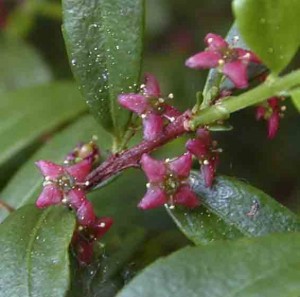The Bittersweet Family is also called Staff-tree Family.
There are about 855 species in the Bittersweet Family, mainly tropical to subtropical. (In Washington there are only 5 species.)
Plant Description: Bittersweet is a family of evergreen or deciduous woody plants including trees, shrubs, and vines. (See note below.) The fruit is often brightly colored. The leaves are simple, with smooth or serrated edges, deciduous or evergreen, and often leather-like. The flowers are usually small and inconspicuous.
Flower Description: There are 4 or 5 sepals which may be distinct or grown together (cone-like). The 4 or 5, 1/8 inch petals are greenish to white, occasionally purplish, spreading to reflexed. The 3 to 5 stamen are alternate between the petals and are attached on, within, or under a conspicuous, flattened or cup-like, fleshy disk. The disk has 2 to 5 carpels fused to it and often has deeply lobed margins. Sometimes sterile stamen are also attached to the disk.
Fruits: Bittersweet fruits are usually capsules or drupes and are often colorful. The seeds are winged or covered with brightly colored (red or orange) arils.
Economic Members: Euonymus (for carving wood and rubber-like latex) and Catha (Khat) and Maytenus (Mayten Tree) for medicinal uses.
Ornamental Members: Catha, Bittersweet, Spindle tree, Maytenus, and Schafferia are grow for their colorful berries, foliage, and bark.
Note: In many ways Grass-of-Parnassus does not fit the description of the Bittersweet Family. Prior to 2003, the genus Parnassia was in the Saxifrage Family. In 2003 the Angiosperm Phylogeny Group put the genus Parnassia in its own family Parnassiaceae, but in 2009, Parnassia was transferred to the Bittersweet Family and reclassified as the genus Parnassia.
This site features 3 species of the Bittersweet Family

